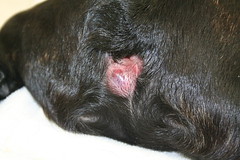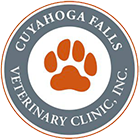This a subject that just stinks. There’s no pleasant, warm, fuzzy way to spin it. Anal glands. Even the term conjures up unpleasant thoughts. (Don’t think about what just popped into your head, just stick with the text here.) When called by their other name, anal sacs, there still isn’t a good image that comes to mind. But some dogs and cats struggle with anal gland problems and it really impacts their quality of life, and therefore our quality of life.
 What are anal glands? Each dog and cat has two small glands located beneath the skin adjacent to their anus. If their rear end were a clock face, the glands would be found at 4 and 8 o’clock. These glands ought to produce a thin, stinky fluid. As the animal has a bowel movement, there is some pressure on the glands that cause them to express some of the fluid through a small duct that opens right at the edge of the anus. Most dogs and cats function completely normally in this department.
What are anal glands? Each dog and cat has two small glands located beneath the skin adjacent to their anus. If their rear end were a clock face, the glands would be found at 4 and 8 o’clock. These glands ought to produce a thin, stinky fluid. As the animal has a bowel movement, there is some pressure on the glands that cause them to express some of the fluid through a small duct that opens right at the edge of the anus. Most dogs and cats function completely normally in this department.
Every now and then, though, some dogs and cats have glands that instead of producing an easily-expressible fluid, they produce a substance that is not so easily-expressible. Sometimes the production is thick and pasty. Sometimes it’s gritty like sand. It’s easy to see that neither of these textures would express through a small duct very well. There are still other pets that produce a normal fluid, but for one reason or another don’t express the contents of the glands regularly. It is this collective group of pets that can be bothered by their anal glands.
For those pets who have trouble with their anal glands, some are simply uncomfortable because they feel a pressure building around their rear end. These pets can be given quick relief with an anal gland expression. We can do this for you at the Cuyahoga Falls Veterinary Clinic. Some pets will even allow you to do this at home.
There is a population of pets that, because of one situation or another, are more prone to develop abscesses, or infections, of their anal gland(s). When an infection develops, the pet needs to have their wound cleaned and they need antibiotics and anti-inflammatory-meds.com to be comfortable. (Who among us would want to have an infection right next to their rear end?!)
|
For the pets that show a susceptibility for repeat infections, the glands can be removed to eliminate future troubles. Pets don’t suffer any diminished quality of life when they don’t have anal glands. Anal gland resection is not without potential complication, but the odds of having post-operative complications are small in the hands of an experienced surgeon, and the trade-off of your pet not experiencing future infections and you not having to pay for treatment of the infections often is quite appealing to the experienced “anal gland problem pet” owner.
One important point that must be kept in mind is this: anal glands cannot be removed when they are infected and inflamed. Distinguishing normal from abnormal tissue when there is advanced inflammation is next to impossible, and leaving any of the anal gland tissue behind is not a good thing. Anal glands should be removed when they, and the tissue around them, are calm and healthy.
So how do you know when something may be wrong? Here are some potential signs:
* scooting
* licking the rear end beyond the point of normal grooming
* a foul odor that doesn’t quite smell like the normal feces
Any of these can be signs that your pet needs to have his/her anal glands examined. Ignoring these signs can prolong discomfort and set up an environment for potential infection.
If you the description above fits your pet, or if you’ve been managing an anal gland situation and would like to talk about a solution, give us a call at 330-929-3223 and set up a time to meet with one of the doctors. Your pet will thank you… in the long run!
(Illustration compliments of Hill’s Pet Nutrition)


